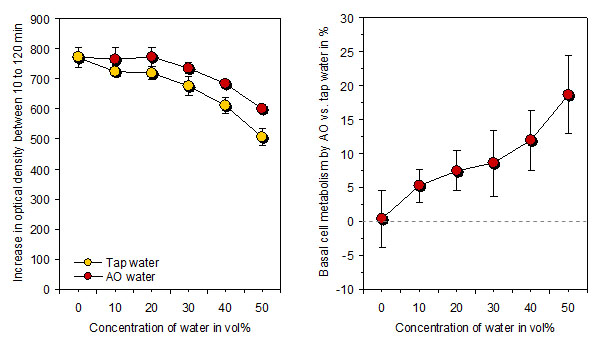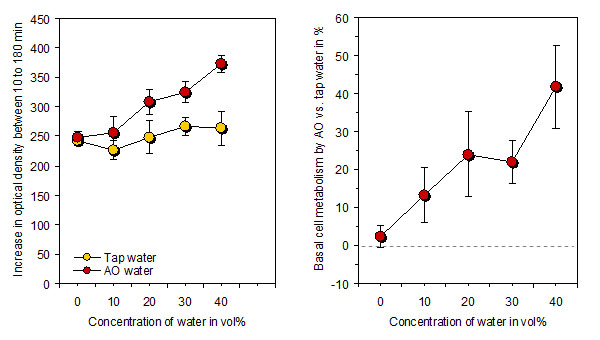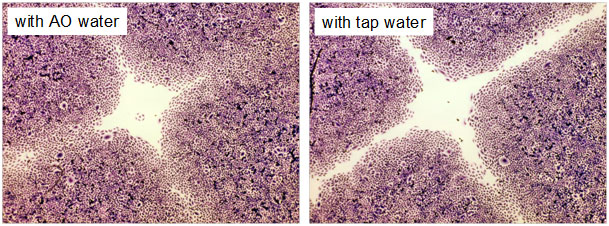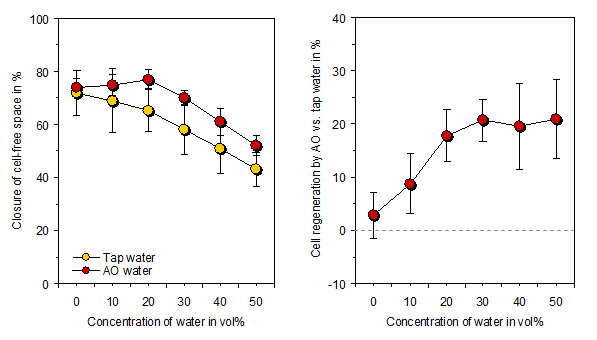Mini Review / Open Access
DOI: 10.31488/jjm.1000135
Investigations on the beneficial cellular effects of tap water before and after treatment with Alpha Omega (AO) water activator
Peter C. Dartsch*
Dartsch Scientific GmbH, Institute for Cell Biological Test Systems, Auf der Vosshardt 25, D-49419 Wagenfeld, Germany
*Corresponding author:Prof. Dr. Peter C. Dartsch, Dartsch Scientific GmbH, Institute for Cell Biological Test Systems, Auf der Vosshardt 25, D-49419 Wagenfeld, Germany, Tel: +49 5444 980 1322;
Abstract
Water is a tasteless, odorless, and nearly colorless chemical substance that is the main constituent of most living organisms. On the other hand, water posesses a number of unique properties which can be explained by natural science only insufficiently. This present study used current cell biological methods to investigate whether tap water, after passing through an unique AO water activator, has received and stored informations that induce beneficial health effects. The effects of AO water on cultured cells (connective tissue fibroblasts and functional neutrophils) were directly compared with the initial tap water without activation. The results show an increased dose-dependent basal metabolic activity for both cell types and an increased regeneration/wound healing process for connective tissue fibroblasts when treated with AO water in comparison to initial tap water. Thus, AO water has clearly demonstrated its beneficial efficacy in relationship to cell metabolism, cell regeneration and front-line defense against invading (microbial) pathogens. From the experiments, a continuous daily intake of AO water can be highly recommended for the improvement and maintenance of well-being.
Keywords: water, L-929 cells, HL-60 cells, cell vitality, cell regeneration, cell culture
Introduction
Water is a tasteless, odorless, and nearly colorless chemical substance that is the main constituent of most living organisms. From the strictly academic point of view, water is just H2O. However, water posesses a number of unique properties which can be explained by natural science only insufficiently.Water is much more than just hydrating the body. Under specific circumstances water molecules can organize themselves into structures, layers or clusters of energy which carry information [1-3]. Moreover, the principle of resonance, one of the omnipresent and omniactive phenomena in nature, can easily reason that vibration carried in water must act on any body which intakes or submerges oneself in it. If these vibrations are beneficial, they may be able to restore healthy resonance in the human body[4,5].
Prompted by that background, the present scientific study used current cell biological methods to investigate whether tap water, after passing through anunique AO water activator has received and stored informations that induce beneficial health effects. The effects of AO water on cultured cells were directly compared with the initial tap water without activation.
Materials and Methods
Origin and test concentrations of water
The basic water of this study was the tap water of the region at the location of DartschScientific, D-49419 Wagenfeld, Niedersachsen, Germany, and was used without (tap water) and after activation by the AO water activator (AO water)
Although the daily intake of water of about 1.5 liters is equivalent to a percentage of only 3 % of the whole body fluid, the continuous daily intake of AO water might cause an accumulation within the body. This consideration is behind the use of higher test concentrations of water up to 50 vol% as performed in this study. This upper limit of tap or AO water added to the culture medium is given by the reduction of osmolarity.
Alpha Omega (AO) water activator
The AO water activator has been developed and is actually distributed by SIA JL Ventures, AO Water Technologies, LV-2111 KekavasNovads, Latvia.The AO water activator can be regarded as a water recorder. Like a storage medium can be recorded by an appropriate device, also water can be specifically charged with the help of an adequate technology. The basic principle of the device is the application of the resonance principle, one of natures omnipresent and omniactive phenomena, that vibration carried in water must act on any body which intakes or submerges oneself in it [4,5]. For the maintainance of health, the beneficial qualities of the vibrational levels stored in water were applied by different natural inorganic materials like lava, quarz sand, amethyst, mountain crystal as well as physical qualities such as flow pattern geometry, vortexes, electromagnetic fields and others.
Cell cultures of connective tissue cells and functional neutrophils
The investigations were conducted with connective tissue fibroblasts of cell line L-929 (ACC-2; Leibniz Institute DSMZ – German Collection of Microorganisms and Cell Cultures, Braunschweig, Germany) and used in the subcultivation stages (passages) 68/69. Cells were routinely grown in RPMI 1640 medium with growth supplements and 0.5 % of gentamycin and incubated at 37 °C in a humidified atmosphere of 5 % CO2 and 95 % air.
Human promyelocytes (cell line HL-60; ACC-3; ECACC 98070106; Leibniz Institute DSMZ – German Collection for Microorganisms and Cell Cultures, Braunschweig, Germany)were routinely cultured in suspension in RPMI 1640 with growth supplements and 0.5 % gentamycin and incubated in an incubator at 37 °C and in a humid atmosphere of 5 % CO2 and 95 % air. By cultivation with 1.5 % dimethylsulfoxide for 5 to 7 days, HL-60 cells were differentiated into functional neutrophils which possess the properties to migrate from the blood stream into the inflamed tissue to destroy invaded pathogens by an oxidative burst [6] and to phagocyte the resulting cell particles.
Examination of basal cell metabolism
For the experiments, cells from subconfluent mass cultures were seeded at a density of 20,000 cells/well in 96-well plates (200 µl culture medium/well) and incubated for 24 h to achieve cell attachment and metabolism. Then, medium was discarded and a reaction mixture of phosphate-buffered saline with calcium and magnesium, 5 mM glucose and a red water-soluble tetrazolium dye named WST-1 (Roche Diagnostics, Mannheim, Germany) was added. Reaction was started after the addition of the appropriate concentration of tap or AO water. Optical density of each well was measured every minute as a differential measurement at ∆OD = 450 – 690 nm with the ELISA reader (BioTEKElx 808). Basal cell metabolism caused a cleavage of the dye and a change in optical density. For evaluation, the linear increase of the curves between 10 and 120min (L-929) or between 10 and 180 min (HL-60) was taken.
Examination of cell regeneration
An increased cell metabolism is usually combined with a stimulation of cell regeneration by proliferation and migration. In order to investigate whether AO water can also stimulate cell regeneration, the cells were seeded at a density of 50,000 cells/ml into the four compartments of silicone culture inserts 4 well (ibidi, Munich, Germany) which have been carefully attached on the surfaces in each well of a 6-well plate. The four compartments are separated by a 500 μm thick wall.
Cells were cultured until a dense cell layer was achieved and the inserts were removed to leave sharp cell-free gaps in form of a cross. Cells were allowed to migrate and proliferate into the cell-free gaps for 24 hours. Then, cells were fixed with methanol, stained with Coomassie-Giemsa solution, air-dried and the width of the remaining cell-free gaps was measured. For each water concentration a total of 6 measurements were performed in triplicate experiments and cell regeneration was calculated by closure of the cell-free gap.
Results
As depicted in Figure 1, AO water caused a dose-dependent stimulation of cell metabolism in comparison to initial tap water with a maximum of approximately 20 % at the highest AO water test concentration. The stimulation became statistically significant at AO water concentrations > 30 vol% (p < 0.01; Wilcoxon-Mann-Whitney test).

Figure 1.Graphical presentation of the absolute (left) and relative (right) test results on the basal cell metabolism of L-929 fibroblasts by AO water in comparison to initial tap water. Tap water values were set as “0” in the right graph. Data represent mean value ± standard deviation of three experiments.
AO water caused a dose-dependent stimulation of cell metabolism of functional neutrophils in comparison to initial tap water with a maximum of approximately 40 % at the highest AO water concentration(Figure 2). The stimulation became statistically significant at AO water concentrations ≥ 20 vol% (p < 0.01; Wilcoxon-Mann-Whitney test).

Figure 2.Graphical presentation of the absolute (left) and relative (right) test results on the basal cell metabolism of differentiated HL-60 cells (functional neutrophils) by AO water in comparison to initial tap water. Tap water values were set as “0” in the right graph. Data represent mean value ± standard deviation of three experiments.
As shown in Figure3 and 4, AO water also caused a dose-dependent stimulation of cell regeneration in comparison to the initial tap water with a maximum of about 20 % at test concentrations ≥ 30 vol%. All test concentrations ≥ 20 vol% differed significantly from the initial tap water (p < 0.01; Wilcoxon-Mann-Whitney test).

Figure 3.Representative micrographs of fixed and stained samples of cell regeneration after 24 hours of continuous incubation with 30 vol% AO water (left) and 30 vol% tap water (right). Note that AO water promotes cell regeneration by a much more extended closure of the cross-like cell-free gaps when compared with tap water without activation.

Figure 4.Graphical presentation of the absolute (left) and relative (right) test results of the increased cell regeneration by AO water in comparison to initial tap water. Tap water values were set as “0” in the right graph. Data represent mean value ± standard deviation of three experiments.
Discussion
Taken together, in all in vitro tests presented here, AO water demonstrated an improved potential to stimulate basic properties of the cells such as basal metabolism, regeneration (proliferation and migration) in comparison to the initial tap water. These findings are in accordance with previous results with natural artesian spring water [7-9] and a completely different technical approach to inform and activate tap water [10]. To my knowledge, these are the first cell culture studies demonstrating the direct beneficial health effects of activated water on specific cellular properties such as metabolism, proliferation and migration.Althoughthe process of subsequent tap water activation is quite difficult to describe from a strictly scientific point of view, the present results show that the initial tap water has obviously been modified to promote the basic properties of cells. This might be even more pronounced when having a regular daily intake, because then the amount of informed AO water increases and might substitute the amount of “normal” water in the organism. The effect is highly interesting, because about 80 % of an adult human is just water and AO water might be one tool for a higher physical performance and the improvement and maintenance of human well-being.
AO water seems to act directly on basal cell features, because its positive influence is not only limited to one single organ-specific cell type. This leads to the conclusion that AO water influences every cell of an organism. As shown here, AO water acts on connective tissue fibroblasts (L-929 cells) as well as on differentiated functional neutrophils (HL-60 cells). Fibroblasts are one of the main cell types which are present in the connective tissue which consists of cells, elastic and collagenous fibers and a carbohydrate ground substance and is not only a protective tissue, but fulfills numerous tasks in the body.The normal wound healing or regeneration process performed by an organism is to restore the integrity of the traumatized organ. In case of connective tissue fibroblasts, mainly the healing process of the skin is attributed. The process involves three successive but overlapping phases, including hemostasis and inflammatory phase, proliferative phase, and remodeling phase [11-13]. The in vitro model of regeneration used in this study simulates the proliferative phase with an increased metabolism, proliferation and migration of the fibroblasts. All three properties together result in a faster closure of the cell-free space by AO water in comparison to the initial tap water.However, it must be considered that the presence of tap or AO watercauses an overall decrease of cell regeneration in the in vitro model because of the concentration-dependent reduction in osmolarity. As a matter of fact, also a concentration-dependent reduction in regeneration could be seen. However, this reduction was much more less significant for the AO water treated cells so that a marked increase in comparison to tap water was the result. The influence of osmolarity as can be seen in this model does not exist in vivo, because osmolarity of the fluid is regulated by osmotic receptor-mediated mechanisms.
The second cell type used in this study, the functional neutrophil, seems to be even more susceptible for AO water with the result of a strong dose-dependent stimulation. Neutrophils, together with basophils and eosinophils, belong to the family of polymorphonuclear cells (PMN) and are normally found in the bloodstream. They are the most abundant type of white blood cells in most mammals. In addition to recruiting and activating other cells of the immune system, neutrophils play a key role in the front-line defense against invading pathogens[14, 15] which corresponds to their ability to mediate a strong oxidative burst through the formation of reactive oxygen species and reactive nitrogen species[6, 16]. When taking the results of the present study into account, it can be stated that AO water is primarily able to stimulate the basal metabolism of functional neutrophils in vitro, which might cause a more activated defense against pathogens.
From the cell biological results presented here, only the resulting beneficial effects on cells can be described. The question still remains open, how the informations of the AO water as a form of vibration or resonance influence the properties of cells. This is a wide field of speculation and we might come to a closer understanding when we are able to measure and specify such informations in the water and their transfer to cells.
Conclusion
In the experimental animal-free tests conducted here with cultured connective tissue cells and functional neutrophils,AO water has demonstrated its beneficial efficacy when compared with the initial tap water in relationship to cell metabolism, cell regeneration and front-line defense against invading (microbial) pathogens. From the experiments, a continuous daily intake of AO water can be highly recommended for the improvement and maintenance of well-being.
Abbreviations
AO water: Alpha Omega water
Conflict of Interest
The author declares no conflict of interests.
References
Tsenkova R. Introduction aquaphotomics: dynamic spectroscopy of aqueous and biological systems describes peculiarities of water. J Near Infrared Spectrosc.2009; 17: 303-314.
Tomasino D.New Technology Provides Scientific Evidence of Water’s Capacity to Store and Amplify Weak Electromagnetic and Subtle Energy Fields. Institute for HeartMath Publication No. 97. 1997; pp. 1-4.
Pollack GH. The Fourth Phase of Water: Beyond Solid, Liquid, and Vapor. 2013; Ebner& Sons Publishers, Seattle, Washington.
Smith CW. Electromagnetic and magnetic vector potential bio-information and water. Homeopathy.2015; 104: 301-304.
Ho M-W. Illuminating water and life: Emilio Del Giudice. ElectromagnBiol Med. 2015; 34: 113-122.
Freitas M, Lima JLFC, Fernandes E. Optical probes for detection and quantification of neutrophils’ oxidative burst. A review.Anal ChimActa.2009; 649: 8-23.
Dartsch PC. Wirkeffekte von Quellwasser. Wissenschaftliche Untersuchungen mit kultivierten Zellen. PraxisMagazin. 2018; 35:30-31.
Dartsch PC. Wasser wirkt. Quell. 2018; 48:28-29.
Dartsch PC. Neue wissenschaftliche Untersuchungen mit kultivierten Zellen. Förderliche Wirkeffekte von Quellwasser. Die Naturheilkunde. 2018; 95: 50-51.
Dartsch PC, Althoff KJ. Investigations on the beneficial effects of Bormia-Water© with cultured cells.Innov Food Technol. 2018; 79: 56-58.
Qing C. The molecular biology in wound healing & non-healing wound.Chinese J Traumatol.2017; 20: 189-193.
Singh S, Young A, McNaught CE. The physiology of wound healing.Surgery (Oxford).2017; 35: 473-477.
Wang PH, Huang BS, Horng HC, Yeh CC, Chen YJ. Wound healing. J Chinese Med Assoc. 2018; 81: 94-101.
Mayer-Scholl A, Averhoff P, Zychlinsky A. How do neutrophils and pathogens interact? Curr Opinion Microbiol.2004; 7: 62-66.
Pruchniak MP, Arazna M, Demkow U. Life of neutrophil: From stem cell to neutrophil extracellular trap. RespPhysiolNeurobiol. 2013; 187: 68-73.
Thomas DC. The phagocyte respiratory burst: Historical perspectives and recent advances. ImmunolLett. 2017; 192: 88-96.
Received: December 14, 2018;
Accepted: December 21, 2018;
Published: December 25, 2018.
To cite this article : Dartsch PC. Investigations on the beneficial cellular effects of tap water before and after treatment with Alpha Omega (AO) water activator. Japan Journal of Medicine. 2018: 2:1.
©Dartsch PC. 2018.
